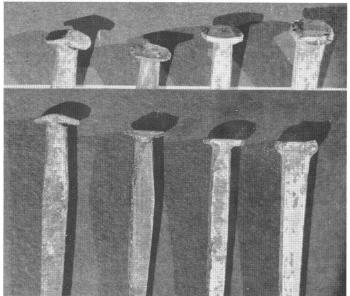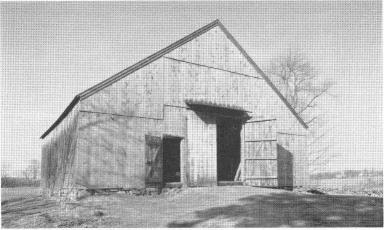NEWSLETTER,
Spring 1991, Vol., 4, Issue 1, Part Two
Machine-made
Nails Aid In Dating Dutch Barns
Text and photographs by Harold Zoch
Nails can be a valuable asset in dating construction
and in dating modifications to buildings. The evidence of handforged
nails is usually recognized, but distinctions between manufactured
nails can be equally valuable clues. The subtle changes in nineteenth
century manufactured nails which have been documented in a pamphlet
by Lee H. Nelson of the National Park Service form the basis
for this article. (Nail Chronology as an Aide to Dating Old
Buildings, American Association for State and Local History,
Technical Leaflet 48, 1968.) Nelson's pamphlet describes the
nail-making process in detail and gives references for further
reading.
Recognizing developments in nail manufacturing methods allows
a researcher to determine, in some cases, the earliest possible
date for erection of a building. There are three basic transitions
in nail chronology. The first is the availability of the first
machine-made nails beginning late in the 1790's. The second hallmark
is the finest quality sheared nail, dating to the 1830's. The
final transition is to round wire nails at about 1850. For the
remainder of this article we will be describing the characteristics
of four sheared nail types. The unique experience which led to
this article is that these four manufactured nail types were
all found in one barn and were all used in its construction.
This barn, the Deertz barn near Middleburgh, discussed in The
Dutch Barn Preservation Newsletter; Spring, 1989, provided the
entire sequence from the first machine made nail to the finalized
sheared type. The word "sheared" will be used since
this was the primary method of machine manufacture for nails
prior to 1850.
Many New World Dutch Barns in the Schoharie area have machine
made nails in original construction as well as in alterations.
This implies Dutch barn construction in this area into the early
nineteenth century. For the specific barn described in this article,
without doubt machine-made nails were used in the original construction,
as well as in the addition. The accompanying illustrations show
the heads and body types of the nails.
The nails were as follows:
TYPE 1. These nails were basically of two
lengths, nominally 4 inches and 2 1/2 to 3 inches. The longer
size was used for securing siding and minor vertical members
on the gabled ends. The shorter were used on roof boards and
rafters. The pentice members and roof boards were also secured
with Type 1 nails. The Type 1 nails were sheared from the parent
material, a rolled iron sheet, and contained the typical shearing
burrs on diagonally opposite corners. According to Nelson, heads
were applied while the nail was placed in a heading tool similar
to the way heads were applied to hand wrought nails. The Type
1 nail in the Deertz barn has the typical two-faceted head but
appears to have been held by a clamping device during heading.
Nails appear to have been heated during the heading operation.
These nails, according to the Nelson article, belong in the period
1790 to mid 1820's.
Original siding remained on two sides of the Deertz barn and
Type 1 nails secured this siding. Since no other nails were used
for this siding, and no other nail holes were found below the
original siding, the barn's erection can be placed in that time
period. (Nelson has recently commented that, in the Philadelphia
area, similar nails were dated to 1812.)
 Manufactured
nails, Types 1, 2, 3, and 4, left to right.
Manufactured
nails, Types 1, 2, 3, and 4, left to right.
TYPE 2. This nail type was used to secure the
tight fitting wall boards in the granary of the Deertz barn.
The other side of the barn had this nail type securing wall boards
and partition boards. Boards used to enclose the tops of these
rooms also appeared to have this type of nail for attaching.
However, the nails there were corroded, making removal and positive
identification difficult. Type 2 nails are completely machine-made
and are characterized by
non-uniform shaped heads which are also not centered on the shank.
Clamping by the machine during heading is most obvious on this
type. Nails were hot during heading. This observation is based
on apparent plastic flow of the metal at the top of the shank.
Nails of this type also were sheared and had shearing burrs on
diagonally opposite sides indicating shearing of nail stock from
a common side. Nails of this type from this barn were 21/2 -
3 inches in length. These nails were of the period from 1815
to the 1830's, suggesting that the granary and partition were
added to the barn some years after its erection. 
Detail of nails, Types 1, 2, 3 and 4, left to
right. Split view shows nail heads.
TYPE
3. A large, and later, addition to this barn contained
the Type 3 nail. This nail appeared to be used, along with
a Type 4 nail to be described, for roof boards and siding
of the addition. Centered along the length of the end rafter
of the original 60-foot-long barn, adjacent to where the
later addition was attached, were the Type 1 nails used to
secure the roof boards of the original barn. On the edge
of this rafter, along its length, were found Type 3 nails,
used to secure the roof boards of the addition. Both Types
3 and 4 were used for securing roofing parts. The Type 3
nail has a better formed head than Type 2, more uniform in
size, but still not centered on the shank. Heads are thicker
than Type 2 nails and appear to be formed with cold working.
Type 3 is the first type of nail used on the barn or addition
which was sheared from both sides, evidenced by the shearing
burrs being on one side. This type of nail is assumed to
be a modernization of the Type 2 nail and was made in the
later part of the 1815 to 1830 period.
TYPE
4. This is the most modern nail, found in the addition
to the original barn. This nail and a Type 3 nail were removed
from a piece of siding original to the addition. Roof material
was nailed with predominantly Type 3 nails. Type 4 nails
constituted 20% of the Type 3 and 4 nails collected. (Twenty-eight
out of 137 nails were Type 4's.) Type 4's have shearing burrs
on a common side indicating the flipping of the nail material,
alternately, from side to side during shearing. Heads are
uniformly centered on the shank and appear to be applied
by cold working. Type 3 and Type 4 nails were approximately
3 inches in length. A change in manufacturing technique seems
to have occurred for the Type 4 nail. Protuberances, which
were formerly centered on the center of the face of the shank,
now are located on the side of the shank where the head and
shank meet (The face of the shank for discussions here is
the portion of the shank which is widest) These protuberances
perhaps are caused by depressions in the heading clamp. Type
4 nails belong to the period after the 1830s. The Type 4
nails, as well as the Type 3 nails, appear to be original
to the addition, suggesting a date after the 1830's for the
extension of the barn.
These four critical nail types from the late 1700s and early
1800's indicate a timespan when some barns here in the Schoharie
Valley were erected. Later most barns were greatly refurbished.
Care must be used in determining what is original construction
and what is repair or improvements. The nail types can be helpful
in understanding when the barns were erected and when the changes
occurred.
Harold Zoch, a two-term President of the Dutch
Barn Preservation Society, has been active in historical and
preservation activities in the Schoharie Valley over a period
of years.

SPECIAL EVENT: The Dutch barn at the William Bull Homestead
near Campbell Hall, in Orange County, will be the focus of a
visit by the Society on June 15, 1991, arranged by Greg Huber.
Photo by Peter Sinclair.